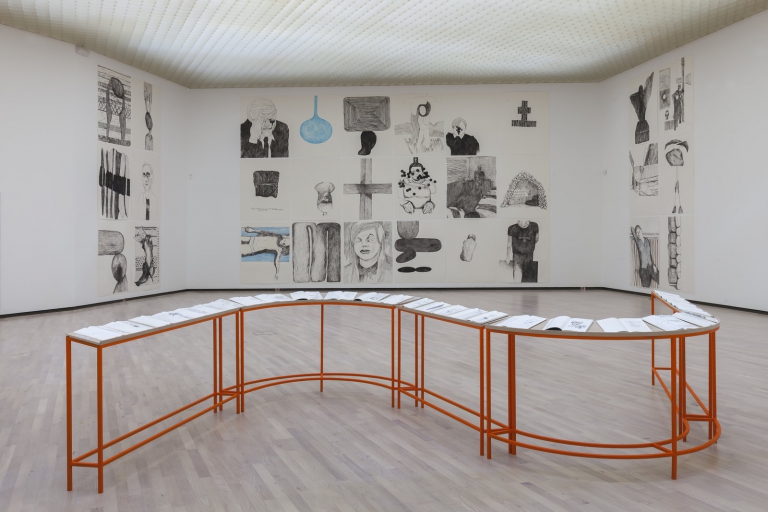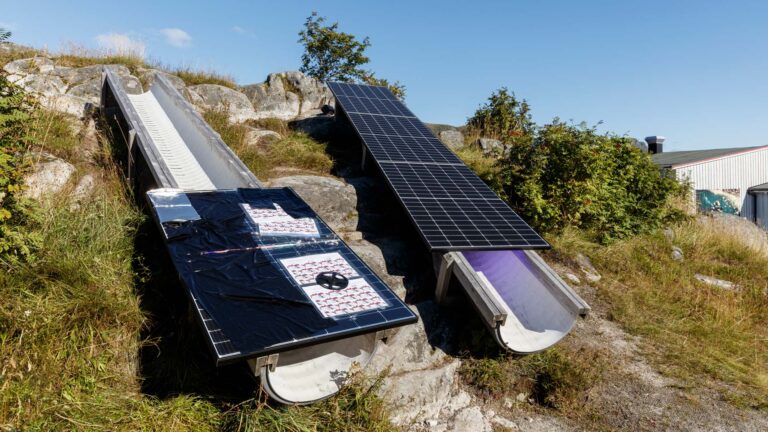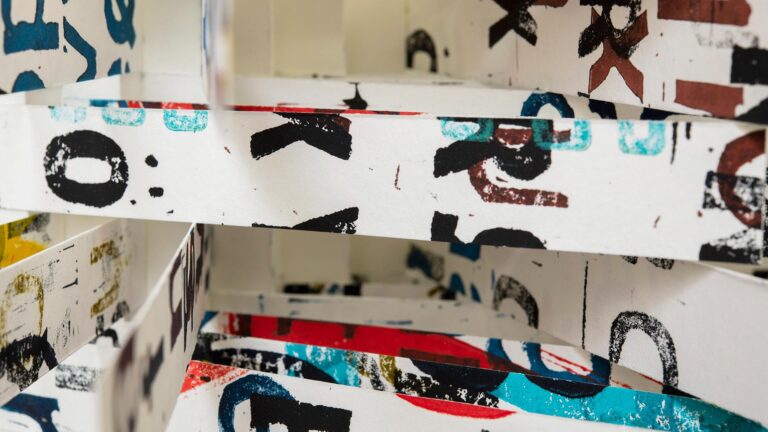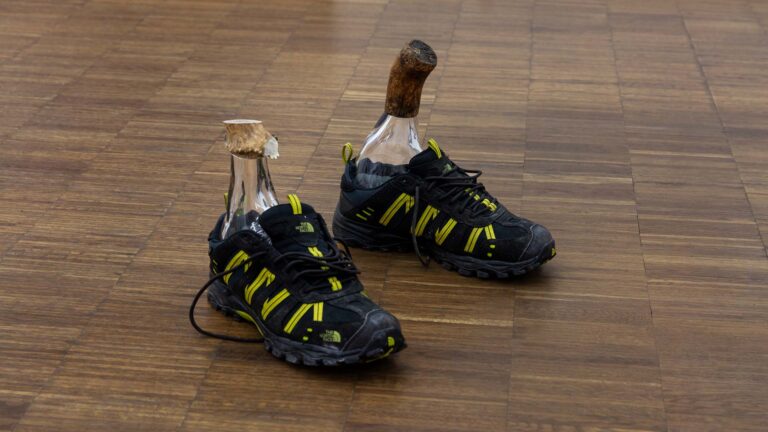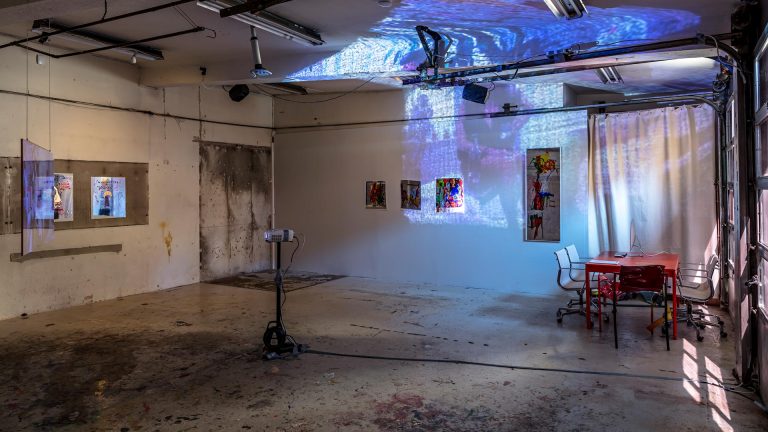Artist: Ane Graff
Exhibition title: There Are Others Here With Me
Venue: OSL Contemporary, Oslo, Norway
Date: August 28 – October 17, 2020
Photography: all images courtesy of the artist and OSL Contemporary, Oslo
Ane Graff – There Are Others Here With Me
Wounds cannot heal…There are always a thousand tiny sicknesses and a thousand tiny healths at work at the same time. – Rick Dolphijn [1]
Here is The Body (2020) and it is altered, which is to say porous, but we do not know that yet. A sculptural homage to Louise Bourgeois’s Fears (1992), Ane Graff’s The Body (2020) implies a direct, uncompromising equivalence between fear and the body, as though a precise diagnosis has finally been attributed to the material incarnation of Bourgeois’s manifold anxieties. We are grounded by this body, this ball that looks like a chained planet, anchoring us to our immediate, Terran surroundings – as if to say ‘you are not just on here, you are of here.’ The body cannot be escaped, much less unlinked from its environment: what strange relief what chilling terror.
The anatomy of Graff’s exhibition at OSL contemporary exercises a practice of de-composition; in Graff’s hands the body is organised into vital constituent parts: Gut-Brain Axis is in dialogue with The Cardiovascular System; The Spleen is suspended and The Nerves stand towards the back, beyond which lies Mouth Wide Open (all 2020). If The Body first appears to be an impermeable solid, its parts attest to the fallacy of perceiving it as such, instead enacting its endless porosity. Everywhere, matter simultaneously dissolves and congeals in fleshy gradients of pink, lavender, brown and burgundy, each work in one possible state of a metamorphic cycle.
These new works extend from Graff’s States of Inflammation presented at the 2019 Venice Bien-nale. There, glass cabinets were inflamed bodies, their chronic inflammation contracted via toxic environments and violent histories passed down and predicated on extraction, industrialisation, and the neo-liberal appetite for growth at all costs. The cabinet-bodies were unwell but curiously beautiful, even borderline-mythical. Larger than life, they stood like vulnerable totems, or petrified deities that might have suffered a spell, their epidermis transformed into transfixing and translucent panes of glass only to expose their compromised innards. Sculptural allegories, as much of human hubris and narcissism as of altered physical states.
Graff draws on the language used to describe physical conditions, and her works often humorously embrace the literalness that only the body can match in sensations of pain or ill-being. At OSL, the cabinet is a nervous system actually in-flamed: a spinal cord hangs inside The Nerves, its outgoing arms each holding a lit candle burning essential oils against inflammation and diffusing anti-bacterial properties. There are traces of dissident surrealism in Graff’s splayed, endoskeletal structure, appropriating something of Alberto Giacometti’s disagreeable objects: an inflamed vagus nerve, after all, is a symptom of a disagreeable system. The candles feel votive too, their flames evoking pleas for improved health and their scent recalling practices of #selfcare, often claimed by the same profit-driven industries that sow the seeds of depletion to begin with. As with much of Graff’s practice, however, their melting is first and foremost the quotidian, miraculous, and disturbing transformation of matter enacted before our eyes and breathed in by our bodies: we too are altered.
There are multiple glass structures in the exhibition that incorporate Graff’s trademark alchemical processes, left to unfold of their own accord. Bottles, cabinets, goblets, recesses are all membranes on, or through which matter flows – poured, emptied, imbibed, fixed, lying stagnant, contained. Graff’s delight in the open-ended possibility of the body’s language to say what mat-ter does is again visible in The Cardiovascular System, which brings into sharp relief the extent to which veins and bodies are vessels: at once containers and circuits for the flux and transmission of liquids, air, signals, synapses, hormones, toxins, cells. The captions outlining the works’ media are legends for endlessly contingent micro-universes of relationality, functioning like ingredient lists that chart unimaginable entanglements of natural, industrial and socio-historical journeys – ‘asphalt dust collected by the Opera tunnel in Oslo’ (Gut-Brain Axis); ‘Royal Raspberry flavour Jelly Made with Halal beef gelatin’ (The Cardiovascular System); ‘Mica pigment powder, glacial grey ochre (glacial till clay deposits made from the wasting ice sheet floating on ponded brackish water from ca. 19,000 years ago (coastal Washington)’ (The Nerves); ‘…lead, cobalt, glycol ethers (from air pollution)’ (Mouth Wide Open); ‘Cochineal Lake pigment (made from the dried, pulverised bodies of the cochineal female scale insects. The beetle was native to the New World, and used by the Aztecs for dyeing and painting, brought to Europe in the 16th century following the Spanish conquest) from Canary Island, Spain’ (The Cardiovascular System).
‘There are others here with me’, Graff’s work whispers, like a haunting. The listed elements and many more besides them are the company Graff keeps, composing the community of others in the show’s title. The haunting seems to be that we are cumulative, our bodies unwitting, often unwilling, vessels for the viscous sediment of history. For Graff, the body is material and embodied memory, the ultimate repository for the consequences of human agency, mutating to its own detriment as it registers and transmits palimpsests of past encounters. Graff practices what Nancy Tuana calls a viscous porosity of flesh: the indiscriminate ‘dance of agency between human and nonhuman agents…once molecular interaction occurs, there is no divide between nature/culture, natural/artificial’[2]; or in Donna Haraway’s words, we are always already ‘naturecultures’[3].
This hurts. Permeability is also a story of trauma, porous flesh is also wounded flesh. An account of the body in Graff’s work is inextricably linked to the history of the narcissistic wound that has impressed upon humans the endlessly incidental and relational nature of our condition on earth. As charted by Sigmund Freud, the journey of the wound appears to be a journey in scale, beginning at the planetary level with the orbit of celestial bodies, progressing via the body into the workings of our inner worlds: Freud begins by naming the Copernican wound, which displaced man’s home as the centre of the universe; followed by the Darwinian wound, which replaced divine creation with evolution and situated humans on the plane of all other living beings; arriving at the Freudian wound, which introduced the subconscious and unseated reason as the primary drive for human actions. Donna Haraway has since suggested a fourth wound, ‘which infolds organic and techno-logical flesh and so melds that Great Divide as well’ [4].
It is less that Graff’s body of work is wounded and more that it embodies this fourth revolution, in its commitment to bearing witness to the dangerous fantasy of human exceptionalism, eroding the perceived divide between nature and culture, and undoing the insistent legacies of Cartesian dualism. We are not a priori, we are only ever relative(s), which is to say, in relation with. About the wound, Graff has written: ‘in its entanglements [the wound is] where and when we are. It is the body as it builds and tears itself apart.’ In her practice, the wound situates us in the continuum of space and time; it is an occurrence to be lived now, and always. Her words remind me of Rick Dolphijn’s: ‘philosophers are not doctors, the aim is not to heal the wound but to be worthy of the cracks and the crises. The shared force of philosophy and the arts, is their ability to find ways to live the wounds that matter to them today’ 5. Being occupied with the crisis – that is the journey Graff’s work takes us on. And it’s intoxicating.
Text by Inês Geraldes Cardoso
OSL contemporary is proud to present our first solo exhibition with Ane Graff. Her artistic practice is informed by feminist new materialisms’ ongoing re-thinking of our material reality, in which a relational and process-oriented approach to matter -including the matter of living bodies- plays an integral part. Within this framework, Graff focuses on human and non-human relationships; viewing human beings as part of an expansive, material network, stretching inside and outside of our bodies. Her work traces the lines of Western intellectual history to ask how the ideas of human exceptionalism, Cartesian dualism and representational thinking all relate to the ecological disasters we face today, and furthermore, what seem to be their current and future implications for material bodies. As the material meetings of our time are new, Graff sees all material bodies as part of an ongoing material experiment, where new substances are being added to the mix (through industrial production and pollution), causing an entangled web of changes and promoting new bodily states. Collaborating with scientists, Graff’s sculptural works often incorporate experimental materials such as bacterial pigments, hair dye, meat glue, phytoestrogens and SSRI antidepressant medications.
Ane Graff (b. 1974, Bodø) lives and works in Oslo, Norway. She graduated from Bergen National Academy of the Arts in 2004 and currently holds a position of PhD Research Fellow at the Oslo Academy of Fine Art. Recent shows include the exhibition “Weather Report – Forecasting Future”, shown at the Nordic Pavilion at the 58th Venice Biennale (curated by Piia Oksanen and Leevi Haapala, KIASMA) and Art Encounters Biennial 2019 (curated by Maria Lind & Anca Rujoiu). Upcoming exhibitions include the 2020 Liverpool Biennale (curated by Manuela Moscoso) and the Rhizome/ New Museum/ Stavanger Kunsthall collaboration 7×7. Previous exhibitions include “Soon Enough: Art in Action”, Tensta Konsthall, Stockholm (2018): “Myths of the Marble”, Henie Onstad Kunstsenter, Oslo, and the Institute of Contemporary Art, Philadelphia (2017); the 11th Gwangju Biennale “The Eighth Climate (What Does Art Do?)”, Gwangju (2016); and ”Surround Audience -The New Museum Triennial 2015”, NY.
[1] Dolphijn, Rick. The Cracks of the Contemporary VI: The Wound, lecture presented at SONIC ACTS FESTIVAL – THE NOISE OF BEING, 25 February 2017 – De Brakke Grond, Amsterdam, The Netherlands.
[2] Tuana, Nancy. 2008. “Viscous Porosity: Witnessing Katrina.” In: Material Feminisms, 188-213, edited by Stacy Alaimo, Susan Hekman. Bloomington, Indianapolis: Indiana University Press.
[3] Haraway, Donna J. 2003. The Companion Species Manifesto: Dogs, People, and Significant Otherness. Vol.1., 1. Chicago: Prickly Paradigm Press.
[4]Haraway, Donna J. 2007. When Species Meet: 03 (Posthumanities), 12. Minnesota: University Of Minnesota Press; Illustrated edition.
[5] Dolphijn, Rick. The Cracks of the Contemporary VI: The Wound, lecture presented at SONIC ACTS FESTIVAL – THE NOISE OF BEING, 25 February 2017 – De Brakke Grond, Amsterdam, The Netherlands
Ane Graff, There Are Others Here With Me, 2020, exhibition view, OSL Contemporary, Oslo
Ane Graff, THE CARDIOVASCULAR SYSTEM, 2020, Hallandia gneiss, steel, glass (Glass structure containing Clear Paraffin Gel Jelly Wax (petroleum production derivative), Royal Raspberry flavour Jelly Made with Halal beef gelatin, MAC Glaze Lipstick in All Fired Up, Crest Complete Cinnamon Rush toothpaste, Cochineal Lake pigment (made from the dried, pulverised bodies of the cochineal female scale insects. The beetle was native to the New World, and used by the Aztecs for dyeing and painting, brought to Europe in the 16th century following the Spanish conquest (from Canary Islands, Spain), Kappa carrageenan (from red edible seaweed used in the food industry for its gelling properties), and PME pink edible lustre spray icing colouring), 50 x 50 x 155 cm
Ane Graff, There Are Others Here With Me, 2020, exhibition view, OSL Contemporary, Oslo
Ane Graff, THE CARDIOVASCULAR SYSTEM, 2020, Hallandia gneiss, steel, glass (detail)
Ane Graff, MOUTH WIDE OPEN II, 2020, Glass, epoxy, plaster. The Goblets (Memory Loss) Melted glass goblet containing: Mercury, silver, tin, zinc, copper (from dental amalgam); arsenic, cadmium, lead, silica dust, polycyclic aromatic hydrocarbons (from Marlboro cigarettes); diisocyanates, manganese, sulphuric acid, nickel, chlorine, chromium, trimethylbenzene, hydrochloric acid, molybdenum trioxide, lead, cobalt, glycol ethers (from air pollution); aluminium zirconium tetrachlorohydrex gly, cyclopentasiloxane, PPG-14 butyl ether, phthalates (from Dove Sensitive antiperspirant stick); diacetyl, perfluorooctanoic acid, tertiary-butyl hydroquinone, trans fats (from microwave popcorn); Saccharomyces cerevisiae yeast, mold, gluten, hardened rapeseed oil (from molded white bread); glucose fructose, syrup, glycerol, E133, corn syrup, starch, E420, salt, sugar (from Cacas black icing color); calcium silicate, sodium (from table salt); aluminium (from aluminium foil); and crushed glass, 70 x 30 x 30 cm
Ane Graff, THE NERVES, 2020, Lavender, fuchsia and coral glass, steel, steel wire and hanging glass structure (made by glass artist Vidar Koksvik). Candles made from paraffin wax (hydrocarbons, fats and oils from petroleum production processes), Swanson Ultra Albion Chelated Manganese capsules, rust pigments (from scrap metal), Mica Powder Skin Safe in Sparkle, glacial grey ochre (glacial till clay deposits made from the wasting ice sheet floating on ponded brackish water from ca. 19,000 years ago (coastal Washington)), blue ochre industrial waste vivianite (made as a purification upcycled pigment from automobile industrial waste from Taiwan), and tea tree, eucalyptus and cedar wood essential oils with anti-inflammatory and anti-bacterial properties, 150 x 130 x 250 cm
Ane Graff, THE NERVES, 2020, Lavender, fuchsia and coral glass, steel, steel wire and hanging glass structure (made by glass artist Vidar Koksvik). Candles made from paraffin wax (hydrocarbons, fats and oils from petroleum production processes), Swanson Ultra Albion Chelated Manganese capsules, rust pigments (from scrap metal), Mica Powder Skin Safe in Sparkle, glacial grey ochre (glacial till clay deposits made from the wasting ice sheet floating on ponded brackish water from ca. 19,000 years ago (coastal Washington)), blue ochre industrial waste vivianite (made as a purification upcycled pigment from automobile industrial waste from Taiwan), and tea tree, eucalyptus and cedar wood essential oils with anti-inflammatory and anti-bacterial properties, 150 x 130 x 250 cm
Ane Graff, THE SPLEEN, 2020, Steel wire and glass2. Glass vessel containing Dagens Næringsliv (Norwegian financial newspaper), Grandma’s White Dirt of Georgia Kaolin Clay Chunks, The Proud Rooster Free Range Eggs, mud and water from Maridalsvannet (the main drinking water supply for Oslo), multiple species of algae and Cyanobacteria, Cacas Sky Cerise Icing colour , Genuine Indigo Blue In Pieces (Idigofera Tinctoria), Logwood Extract powder (a spiny, tropical American tree, largely found in the Yucatan Peninsula of Mexico. The extract is a purple-red dye derived from processing the darkest heartwood), 27 x 10 x 44 cm
Ane Graff, THE SPLEEN, 2020, Steel wire and glass2. Glass vessel containing Dagens Næringsliv (Norwegian financial newspaper), Grandma’s White Dirt of Georgia Kaolin Clay Chunks, The Proud Rooster Free Range Eggs, mud and water from Maridalsvannet (the main drinking water supply for Oslo), multiple species of algae and Cyanobacteria, Cacas Sky Cerise Icing colour , Genuine Indigo Blue In Pieces (Idigofera Tinctoria), Logwood Extract powder (a spiny, tropical American tree, largely found in the Yucatan Peninsula of Mexico. The extract is a purple-red dye derived from processing the darkest heartwood), 27 x 10 x 44 cm
Ane Graff, THE GUT-BRAIN AXIS, 2020, Vånga granite. How the West Came to Rule: The Geopolitical Origins of Capitalism, Alexander Anievas and Kerem Nisancioglu (Pluto Press, 2015), and The Betty Crocker Big Book of Cupcakes, Betty Crocker (Wiley, 2011), steel wire mesh, potassium aluminium sulphate, Solgar Naturally Sourced Vitamin K MK-7 from Natto extract, road dust from the Opera tunnel in Oslo, Yerba Prima activated coconut charcoal, powdered Cephalon Provigil (narcolepsy medication and cognitive enhancer), Titanium dioxide (food-grade pigment), Taylor of Old Bond Street Talc Powder, Urban Decay Moondust Eyeshadow in Blackout, 50 x 50 x 115 cm
Ane Graff, THE BODY,2020, Steel and oak wood, 130 x 60 x 60 cm
Ane Graff, THE BODY,2020, Steel and oak wood, 130 x 60 x 60 cm
Ane Graff, THE CARDIOVASCULAR SYSTEM, 2020, Hallandia gneiss, steel, glass (Glass structure containing Clear Paraffin Gel Jelly Wax (petroleum production derivative), Royal Raspberry flavour Jelly Made with Halal beef gelatin, MAC Glaze Lipstick in All Fired Up, Crest Complete Cinnamon Rush toothpaste, Cochineal Lake pigment (made from the dried, pulverised bodies of the cochineal female scale insects. The beetle was native to the New World, and used by the Aztecs for dyeing and painting, brought to Europe in the 16th century following the Spanish conquest (from Canary Islands, Spain), Kappa carrageenan (from red edible seaweed used in the food industry for its gelling properties), and PME pink edible lustre spray icing colouring), 50 x 50 x 155 cm
Ane Graff, THE CARDIOVASCULAR SYSTEM, 2020, Hallandia gneiss, steel, glass (Glass structure containing Clear Paraffin Gel Jelly Wax (petroleum production derivative), Royal Raspberry flavour Jelly Made with Halal beef gelatin, MAC Glaze Lipstick in All Fired Up, Crest Complete Cinnamon Rush toothpaste, Cochineal Lake pigment (made from the dried, pulverised bodies of the cochineal female scale insects. The beetle was native to the New World, and used by the Aztecs for dyeing and painting, brought to Europe in the 16th century following the Spanish conquest (from Canary Islands, Spain), Kappa carrageenan (from red edible seaweed used in the food industry for its gelling properties), and PME pink edible lustre spray icing colouring), 50 x 50 x 155 cm
Ane Graff, THE GUT-BRAIN AXIS, 2020, Vånga granite. How the West Came to Rule: The Geopolitical Origins of Capitalism, Alexander Anievas and Kerem Nisancioglu (Pluto Press, 2015), and The Betty Crocker Big Book of Cupcakes, Betty Crocker (Wiley, 2011), steel wire mesh, potassium aluminium sulphate, Solgar Naturally Sourced Vitamin K MK-7 from Natto extract, road dust from the Opera tunnel in Oslo, Yerba Prima activated coconut charcoal, powdered Cephalon Provigil (narcolepsy medication and cognitive enhancer), Titanium dioxide (food-grade pigment), Taylor of Old Bond Street Talc Powder, Urban Decay Moondust Eyeshadow in Blackout, 50 x 50 x 115 cm
Ane Graff, THE NERVES, 2020, Lavender, fuchsia and coral glass, steel, steel wire and hanging glass structure (made by glass artist Vidar Koksvik). Candles made from paraffin wax (hydrocarbons, fats and oils from petroleum production processes), Swanson Ultra Albion Chelated Manganese capsules, rust pigments (from scrap metal), Mica Powder Skin Safe in Sparkle, glacial grey ochre (glacial till clay deposits made from the wasting ice sheet floating on ponded brackish water from ca. 19,000 years ago (coastal Washington)), blue ochre industrial waste vivianite (made as a purification upcycled pigment from automobile industrial waste from Taiwan), and tea tree, eucalyptus and cedar wood essential oils with anti-inflammatory and anti-bacterial properties, 150 x 130 x 250 cm
Ane Graff, THE NERVES, 2020, Lavender, fuchsia and coral glass, steel, steel wire and hanging glass structure (made by glass artist Vidar Koksvik). Candles made from paraffin wax (hydrocarbons, fats and oils from petroleum production processes), Swanson Ultra Albion Chelated Manganese capsules, rust pigments (from scrap metal), Mica Powder Skin Safe in Sparkle, glacial grey ochre (glacial till clay deposits made from the wasting ice sheet floating on ponded brackish water from ca. 19,000 years ago (coastal Washington)), blue ochre industrial waste vivianite (made as a purification upcycled pigment from automobile industrial waste from Taiwan), and tea tree, eucalyptus and cedar wood essential oils with anti-inflammatory and anti-bacterial properties, 150 x 130 x 250 cm
Ane Graff, THE NERVES, 2020, Lavender, fuchsia and coral glass, steel, steel wire and hanging glass structure (made by glass artist Vidar Koksvik). Candles made from paraffin wax (hydrocarbons, fats and oils from petroleum production processes), Swanson Ultra Albion Chelated Manganese capsules, rust pigments (from scrap metal), Mica Powder Skin Safe in Sparkle, glacial grey ochre (glacial till clay deposits made from the wasting ice sheet floating on ponded brackish water from ca. 19,000 years ago (coastal Washington)), blue ochre industrial waste vivianite (made as a purification upcycled pigment from automobile industrial waste from Taiwan), and tea tree, eucalyptus and cedar wood essential oils with anti-inflammatory and anti-bacterial properties, 150 x 130 x 250 cm
Ane Graff, There Are Others Here With Me, 2020, exhibition view, OSL Contemporary, Oslo





















